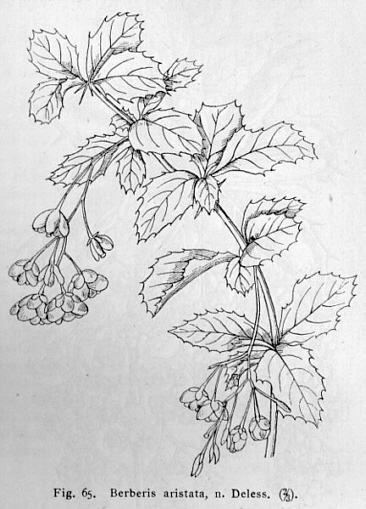

Zitierweise / cite as:
Carakasaṃhitā: Ausgewählte Texte aus der Carakasaṃhitā / übersetzt und erläutert von Alois Payer <1944 - >. -- Anhang A: Pflanzenbeschreibungen. -- Berberis aristata DC. -- Fassung vom 2007-06-27. -- URL: http://www.payer.de/ayurveda/pflanzen/berberis_aristata.htm
Erstmals publiziert: 2007-06-27
Überarbeitungen:
Anlass: Lehrveranstaltung SS 2007
©opyright: Dieser Text steht der Allgemeinheit zur Verfügung. Eine Verwertung in Publikationen, die über übliche Zitate hinausgeht, bedarf der ausdrücklichen Genehmigung des Verfassers
Dieser Text ist Teil der Abteilung Sanskrit von Tüpfli's Global Village Library
WARNUNG: dies ist der Versuch einer
Übersetzung und Interpretation eines altindischen Textes. Es ist keine
medizinische Anleitung. Vor dem Gebrauch aller hier genannten Heilmittel wird
darum ausdrücklich gewarnt. Nur ein erfahrener, gut ausgebildeter ayurvedischer
Arzt kann Verschreibungen und Behandlungen machen!
Falls Sie die diakritischen Zeichen nicht dargestellt bekommen, installieren Sie eine Schrift mit Diakritika wie z.B. Tahoma.
Verwendete und zitierte Werke siehe: http://www.payer.de/ayurveda/caraka0001.htm

Abb.: Berberis aristata
DC. - Begrannte Berberitze
[Bildquelle: Wikipedia]
Drury:
"Berberis lycium (Royle). N. O. Berberideae.
- Raisin Berberry, Eng.
Description.—Shrub, 6-8 feet; spines trifid or simple; leaves oval, curveated or elliptical, mucronate, smooth, under surface, glaucous, entire or spinulosely toothed; racemes short, many-flowered, corymbose, shorter than the leaves.; pedicels elongated, 1-flowered; berries purplish; flowers small, yellow. Fl. May—June.-------Nepaul. Kumaon.
Medical Uses.—This plant is distinguished from other species by the very short racemes of its flowers. The fruit is oblong, purplish or pinkish, wrinkled and covered with bloom like that of the best raisins. Among many conflicting opinions of botanists it becomes difficult to identify the several described species of Berberis. It has now been definitively settled by Dr Royle that this is the Lycium Indicum of Dioscorides, over which much doubt has hung for a long period. The medicine it yields is of the highest antiquity, and has been known to the Hindoos from very early ages. The most celebrated part is the extract called Rusot, which is prepared by digesting in water pieces of' the root, stem, and branches. This is frequently employed as a remedy in ophthalmia, especially useful after the acute symptoms have subsided. Some say that it is one of the best applications ever used in that complaint. The tincture, which is also prepared from the bark of the root, is recommended as preferable to the extract. It is very bitter, yielding a principle called Berberine. As a medicine it is reckoned exceedingly valuable, and is easily prepared where the plant is indigenous. According to Dr O'Shaughnessy, the medicine is best administered as a febrifuge, promoting digestion and acting as a gentle but certain aperient. In ague and remittent fevers, it is peculiarly useful, and by some it is reckoned only second to quinine, externally either alone or with equal parts of alum and opium mixed up in water and applied round the eye. The B. lycium is found at a lower elevation (viz. at 3000 feet) than any of the other species, and therefore may be acclimated in the plains.
All the species of Berberry are supposed to possess similar properties in a greater or less degree. There has been much confusion in arranging them, but the following may perhaps be enumerated as distinct plants:—
B. aristata.—Spines very stiff and three parted; leaves oblong-or oblong-lanceolate, nearly entire or toothed, sometimes deeply or coarsely veined; flowers in long loose slender racemes.-------Common in Northern India, distinguished by its slender pendulous or erect racemes of flowers, longer than the leaves, and not corymbose.
B. Sinensis.—Spines 3-5 or more; leaves lanceolate, very acute, much netted, entire, or regularly toothed; flowers numerous, in drooping racemes not much longer than the leaves.-------Found in Northern India and China.—Berries are said to be dark purple.
B. Wallichiana.— Spines long, slender, 3-parted; leaves oblong-• lanceolate, deep green, sharp-pointed, finely serrated; flowers very numerous, in clusters shorter than the leaves.------'Native of Nepaul at very high elevations.
B. Nepaulensis.—Leaves 3-5 pairs, ovate; leaflets spiny, toothed; racemes upright, slender, elongated; fruit bluish purple.-------Native of mountainous parts in Northern India, growing 10-12 feet high at 8000 feet elevations. Said to be one of the finest of the species. It differs very little from B. Leschenaultii.—(W. & A.. Prod. i. 16.)—Boyle. Loudon. Indian Ann. of Med. Science."
[Quelle: Drury, Heber <1819 - 1872>: The useful plants of India : with notices of their chief value in commerce, medicine, and the arts. -- 2d ed. with additions and corrections. London : Allen, 1873. -- xvi, 512 p. ; 22 cm. -- s.v.]